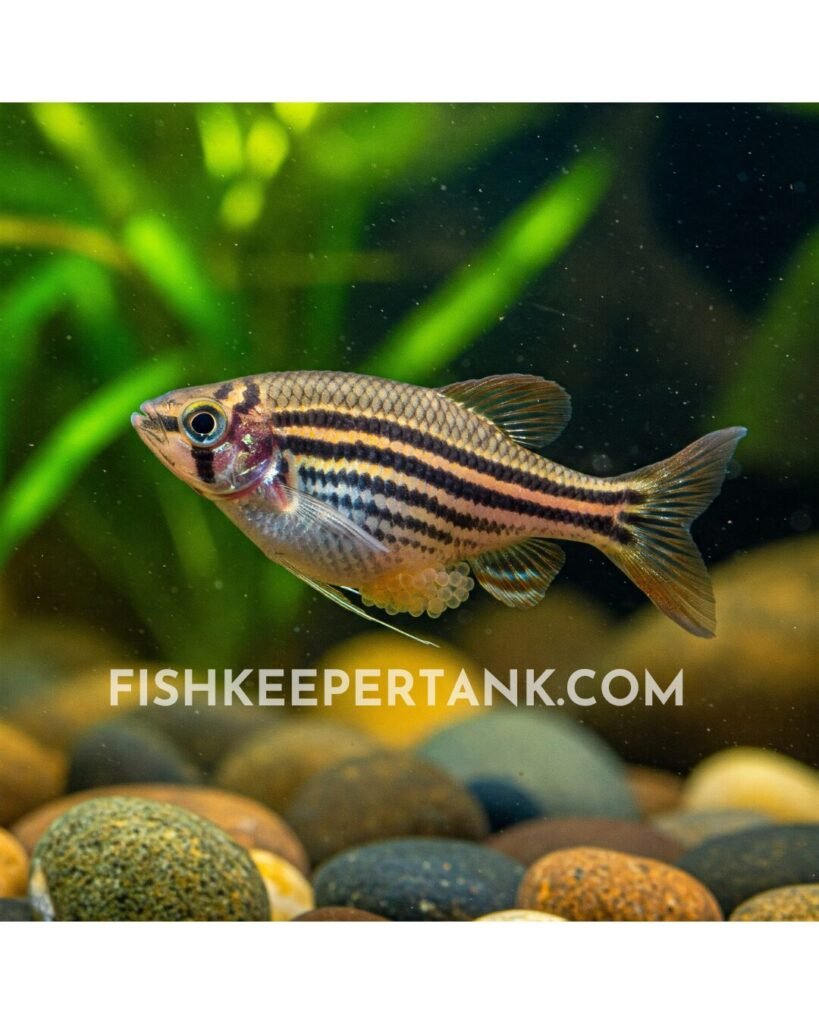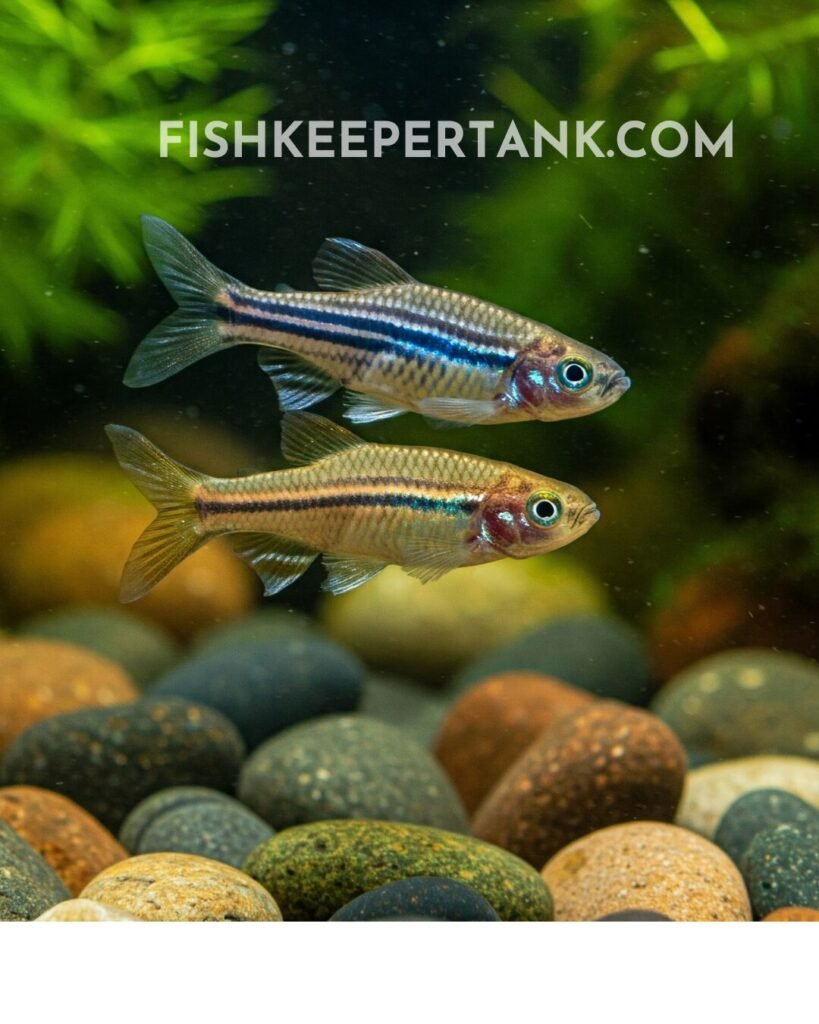Introduction
If you’re an aquarium enthusiast, you might be wondering, “What does a pregnant Zebra Danio look like?” The scientifically classified Danio rerio family belongs to the most commonly kept aquarium fish because they show strong adaptability and tend to play while displaying distinctive horizontal banding across their bodies.
However, unlike mammals, Zebra Danios do not experience pregnancy in the traditional sense. The Zebra Danio reproduction process functions as an egg layer system because females produce eggs within their bodies, which males externally fertilize. Understanding the signs of a pregnant Zebra Danio, their breeding behavior, and proper care techniques will help you ensure a successful reproduction process and the survival of their fry. This guide: “What Does a Pregnant Zebra Danio Look Like? Fish Keeper Tank Guide” provides a detailed look at pregnant Zebra Danios, covering everything from physical signs to breeding care and fry development.
Key Takeaways
- Zebra Danios do not get “pregnant” in the mammalian sense but rather carry eggs before laying them.
- Physical signs of a pregnant Zebra Danio include a swollen belly, changes in size, and slight color variations.
- Behavioral signs include increased appetite, nesting behavior, and males chasing the females.
- Proper breeding conditions, water parameters, and nutrition ensure healthy egg development and successful hatching.
- Adult Zebra Danios do not provide parental care, and eggs should be protected from being eaten.

Zebra Danio Habitat
To care for pregnant Zebra Danios properly, it’s essential to understand their natural habitat and how to recreate it in captivity.
In the Wild:
Native to South Asia, Zebra Danios are commonly found in:
- Slow-moving freshwater streams, ponds, and rice paddies in India, Bangladesh, and Nepal.
- Their tropical environment includes waters which stay between 64–77°F (18–25°C).
- The presence of aquatic plants combined with vegetation creates multiple hiding areas and a suitable environment for breeding activities.
- Sand and small pebbles work well together as suitable bottom materials because they support egg-laying processes.
In Captivity:
To ensure a healthy environment for pregnant Zebra Danios, their tanks should mimic their natural habitat:
- Tank Size: A minimum of 10 gallons for a small group.
- Temperature: Maintain between 72–78°F (22–26°C) for optimal breeding.
- The optimal water conditions require proper pH levels of 6.5 to 7.0 with excellent oxygenation.
- Fine gravel or sand should be chosen as a substrate because injury risks will be minimized.
- For egg safety, Java Fern, spawning mops, floating plants, and Moss Balls should be included to create secure spaces.
- Sponge filters should be used to clean tank water while preventing fry from entering the filtration system.
- System maintenance in tanks enhances the probability of developing and hatching successful eggs.
Signs of Pregnant Zebra Danio
To determine if your Zebra Danio is pregnant (carrying eggs), observe both physical and behavioral changes.
Physical Signs:
Change in Shape and Size
One of the most obvious signs of a pregnant Zebra Danio is a noticeable increase in body size. During pregnancy, female Zebra Danios develop a round belly, making their shape appear fuller than their typical slender male form.
Swollen Belly
A pregnant Zebra Danio’s belly becomes visibly swollen, especially near the lower abdomen. The egg development process in Zebra Danio fish differs from that of live-bearing fish such as guppies, as these fish do not display a gravid spot.
Change in Color
Some pregnant Zebra Danios may display a deeper coloration, especially in their abdominal region, due to hormonal changes related to egg development.
Behavioral Signs:
Change in Appetite
A pregnant Danio fish often eats more than usual, requiring additional energy for egg production. A few female fish will develop a loss of appetite shortly before laying eggs.
How Long Can Betta Fish Go Without Food?
Female Zebra Danio Nesting
While Zebra Danios do not build nests, a pregnant Zebra Danio may start spending more time near plants, searching for a suitable spot to scatter her eggs.
Male Following Female
Breeding indication occurs when males fiercely pursue females while using their bodies to stimulate egg release from their bellies. The strong behavior of the male chasing the female indicates the female fish is near the start of spawning.
Can Male and Female Betta Fish Live Together?
Aggressive Toward Other Fish
Breeding causes both male and female Danios to exhibit greater fights among themselves. Spawning territory becomes the focus of male competitive behavior, while the female defends this area from other fish through aggressive behavior.

Zebra Danio Pregnancy Facts
- Pregnant Zebra Danios carry eggs for approximately 2–4 days before laying them.
- Each spawning activation can lead to the tank becoming home to 300–400 spread eggs.
- Hatching occurs in 48–72 hours, although the process depends on water temperatures.
- Zebra Danios do not care for their eggs, and adults often eat them if left unprotected.
How Does The Zebra Danio Pregnancy Work?
Unlike live-bearing fish, Zebra Danios reproduce through external fertilization.
- During pregnancy, the female fish contains eggs within her body for a few days.
- Upon spawning, the female fish empties her eggs across either the tank floor or plant territory.
- When males fertilize the eggs externally, they scatter their sperm over them.
- The embryo development starts, with eggs becoming fry through hatching within 48–72 hours.
Male vs. Female Zebra Danio
| Feature | Male Zebra Danio | Female Zebra Danio |
|---|---|---|
| Body Shape | Slim and streamlined | Rounder, especially when carrying eggs |
| Coloration | Brighter with a golden hue | Slightly duller, silver undertones |
| Size | Slightly smaller | Slightly larger |
| Breeding Behavior | Chases females, nudges them to spawn | Scatters eggs when ready |

Zebra Danio Breeding Process
The reproduction procedure includes these sequential actions:
- During courtship periods, males will chase females before pushing them to reproduce.
- Female Zebra Danios discharge their eggs either into plants, gravel areas, or alternative open spaces.
- External Fertilization occurs when males spread sperm over the pool of eggs for fertilization.
- The complete incubation process of eggs results in fry that appear after 48-72 hours.
How to Take Care of Pregnant Zebra Danio
Make a Separate Breeding Tank
- Equip a 5–10 gallon tank with a fine mesh to defend eggs.
- The water requirements include maintaining proper stability and cleanliness.
- Regular inspections should include weekly 25-30% water changes alongside the use of a sponge filter to guarantee fry safety.
Feed a Varied Diet
- Providing Zebra Danios with a combination of live foods, flakes, and vegetable ingredients will optimize the development of their eggs.
Observe and Monitor Their Behavior
- Regular observation of behavior will help identify stress signals, lethargic movements, and agitated behavior to assess pregnancy health.
Conclusion
Understanding how to identify and care for a pregnant Zebra Danio is crucial for successful breeding. Providing a suitable habitat with good food and a specific breeding area helps guarantee successful egg production and healthy fry maturation.
Frequently Asked Questions
Q: How long are Zebra Danios pregnant for?
A: Zebra Danios don’t actually get pregnant! They are egg scatterers, meaning the female releases eggs and the male fertilizes them externally. So, they don’t carry their young like mammals. The female’s belly will appear swollen when she’s carrying eggs, but this isn’t pregnancy.
Q: Are Danios livebearers or do they lay eggs?
A: Danios are not livebearers. They lay eggs.
Q: Do Zebra Danios eat their eggs?
A: Yes, Zebra Danios, like many fish, will eat their own eggs if given the chance. This is why it’s important to provide them with a suitable spawning environment (see below).
Q: Do Zebra Danios eat their babies (fry)?
A: Yes, Zebra Danios will also eat their fry. This is another reason why separating the parents after spawning or providing plenty of hiding places for the fry is crucial for successful breeding.
Q: How long do Danios carry their eggs?
A: Since they are egg scatterers, females carry the eggs internally until they are ready to be released. This period can vary but is generally a few days to a week, depending on the fish’s condition and environmental factors.
Q: How do I know when my Danio is ready to lay eggs?
A: A female Danio ready to lay eggs will have a noticeably swollen belly. She may also appear more rounded overall. Males will often become more active and chase the female, indicating they are ready to spawn.
Q: What should I do if my zebra danio is not laying eggs?
A: Several factors can influence egg-laying. Ensure you have a proper spawning setup (see below), including appropriate water parameters (temperature, pH), a varied diet, and both male and female Danios present. If conditions are right, it may simply be a matter of time. Sometimes, it can take a bit of patience. If you suspect a health issue, consult with an experienced aquarist or a veterinarian specializing in fish.
Q: How long do Zebra Danios live?
A: Zebra Danios typically live for 3-5 years, though they can sometimes live longer with proper care.
Q: How can you tell if a Zebra Danio is male or female?
A: Females are usually larger and rounder, especially when carrying eggs. Males are generally slimmer and more streamlined. Males also often have brighter colors and more elongated fins.
Q: Are zebra danios easy to breed?
A: Yes, Zebra Danios are considered relatively easy to breed, making them a good choice for beginners.
Q: Can zebra and leopard danios breed?
A: While they are closely related, zebra and leopard danios are different species and generally will not interbreed successfully.
Q: Where do zebra danios lay eggs?
A: In their natural habitat, Zebra Danios scatter their eggs among plants and substrate. In an aquarium, providing marbles, fine gravel, or a spawning mop can give them a suitable surface to lay their eggs on.
Q: How long do zebra danios lay their eggs?
A: The actual egg-laying process is quite quick, usually only lasting a few hours. The fish will spawn multiple times over a period of several days.
Q: How can you tell if a zebra danio egg is fertilized?
A: Fertilized eggs will usually appear translucent or slightly amber-colored. Unfertilized eggs often turn white or opaque and will eventually develop fungus.
Q: What’s the best setup for breeding Zebra Danios?
A: A separate breeding tank is recommended. Include a layer of marbles or fine gravel on the bottom to protect the eggs from the parents. Maintain a temperature around 78-80°F (25-27°C). Provide some gentle water flow. After the spawning is complete, remove the parents to prevent them from eating the eggs and fry.
How long does it take for Zebra Danios to lay eggs?
Female Zebra Danios typically lay eggs within 2–4 days after developing them.
How can I tell if my Zebra Danio is male or female?
Females have a rounder belly and a slightly less vibrant coloration, whereas males are slimmer and more golden in hue.
Why do Zebra Danios eat their own eggs?
Zebra Danios lack parental instincts and will often eat their own eggs if not separated. A breeding tank helps prevent this.
How many eggs do Zebra Danios lay?
A female can lay between 300–400 eggs at a time, though not all will survive to adulthood.
Can I breed Zebra Danios in a community tank?
It’s possible but not recommended. Other fish, including the Danios themselves, will likely eat the eggs. A separate breeding tank increases survival rates.
- Q: Can Rabbit Snails be kept with aggressive fish?
- A: No, it’s best to avoid aggressive species as they may harm Rabbit Snails.
- Q: What do Rabbit Snails eat besides algae?
- A: They also enjoy blanched vegetables and high-quality sinking pellets.
- Q: How often do Rabbit Snails reproduce?
- A: Rabbit Snails tend to reproduce once they reach maturity, usually taking about 6 months.
- Q: Are Rabbit Snails easy to care for?
- A: Yes, they are low-maintenance and can adapt well to various aquarium conditions as long as their basic needs are met.
People Also Read:

